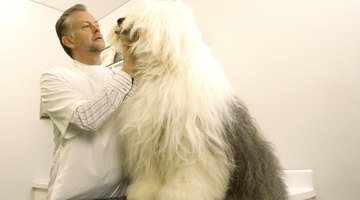A career as a vet may beckon if you enjoy working with animals and can master difficult science subjects. Although many veterinarians work in private clinics, others spend the workday visiting farms and ranches to treat large animals. Whatever the type of practice, a vet's work often continues after dark and on the weekend. A veterinarian needs approximately eight years of college and veterinary school combined, but some vets also complete internships and residencies.
Undergraduate Requirements for a Veterinarian Degree
Competition for admission to veterinary school is keen, and most applicants already have a four-year bachelor's degree. An actual degree isn't mandatory, but you must complete the prerequisites required by the particular school. Requirements to become a veterinarian through most veterinary programs require undergraduate science classes in chemistry, biology, microbiology, anatomy and physiology. Animal science is also usually required, and some programs require math, social sciences or humanities. In addition to classes, some veterinary colleges place special emphasis on work with animals in weighing applications. Experience working at a veterinary clinic, animal shelter or farm will give you an advantage in getting into professional school.
Veterinarian School Requirements
A veterinarian degree can only be earned from an accredited veterinarian school. Veterinary schools receive accreditation from the Council on Education of the Association of American Veterinary Medical Colleges. A search tool for accredited programs is available on the AAVMC website. Although programs vary, veterinary college usually takes four years, culminating in a Doctor of Veterinary Medicine degree. During the first three years of most programs, students divide their time among class, lab and clinical work. Some typical course requirements include animal science, veterinary pharmacology, animal physiology, veterinary epidemiology, systemic pathology and cardiovascular diseases.
Veterinary Clinical Rotations
In a typical veterinary program, students spend their fourth year in clinical rotations in animal hospitals and clinics, although some programs devote additional time to clinical work. At the Michigan State University College of Veterinary Medicine, for example, students must take 33 credits of rotations, called clerkships, plus 27 additional clerkship or elective credits. Some of the nine required rotations are diagnostic pathology, food animal medicine and surgery, small animal general medicine and anesthesiology.
Licensing Requirements for Veterinarians
After completing a doctoral degree, a Doctor of Veterinary Medicine must obtain a state license to practice. The laws vary, but every state requires an accredited veterinary degree and a passing score the North American Veterinary Licensing Exam. This is a 360-question computer-based exam available through Prometric testing centers throughout North America. Many states have additional licensing requirements, usually including a test on the laws relevant to veterinary practice in the particular state.
Veterinary Internship and Residency Requirements
Although not required, many veterinarians extend their education by completing a one-year internship in a hospital or clinic. By providing additional work experience, an internship gives new graduates an advantage in competing for jobs. Some vets also complete a residency in one of 40 specialties recognized by the American Veterinary Medical Association, such as internal medicine. A residency typically takes between three and four years, depending on the choice of specialty. After completing a residency, a veterinarian is eligible to take an AMVA exam for certification as a specialist.
Veterinarian Career Statistics
The average salary for veterinarians was $101,530 per year in 2017, according to the U.S. Bureau of Labor Statistics. However, the highest-earning 10 percent received $159,320 or more annually. The BLS predicts a 19 percent growth in jobs for vets between 2016 and 2026, considerably more than the rate of increase for all occupations. Prospects for new graduates in this growing market will be good because only approximately 2,500 students complete accredited programs each year.
Related Articles
References
Resources











